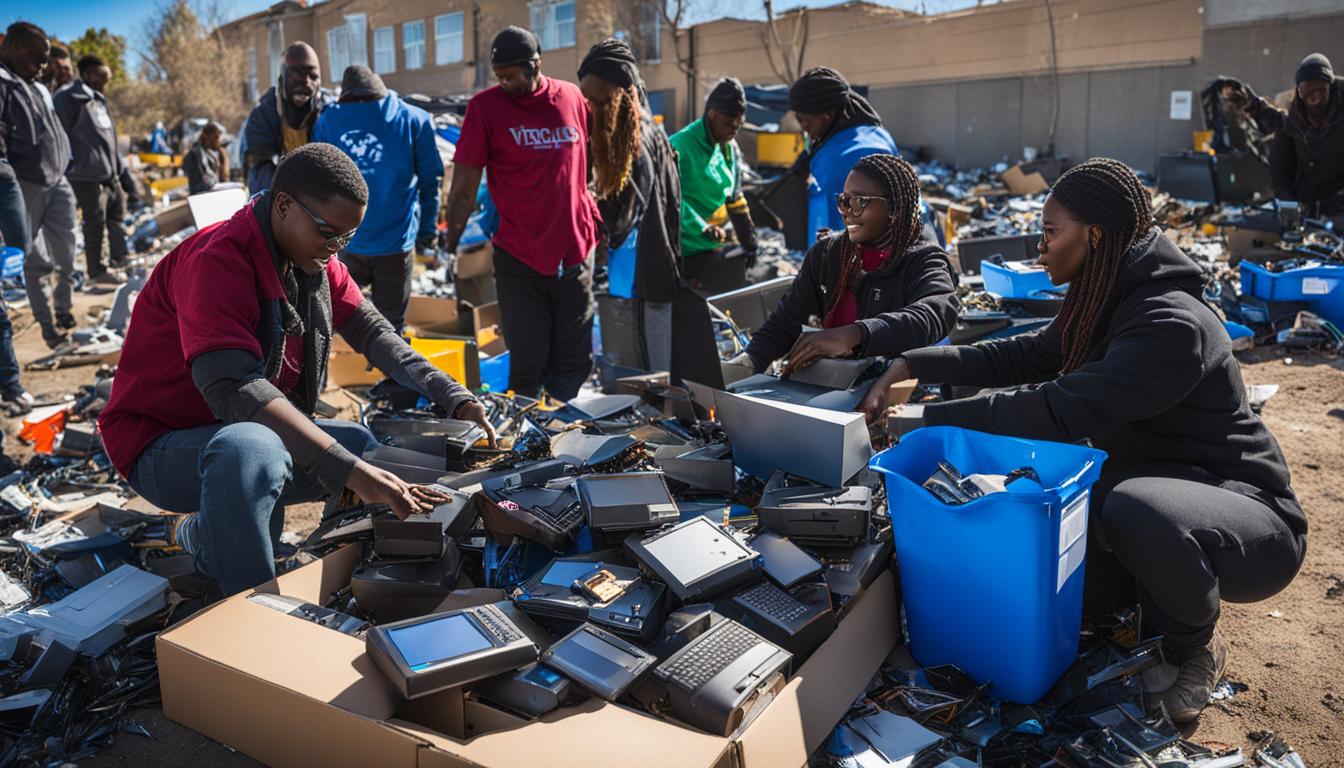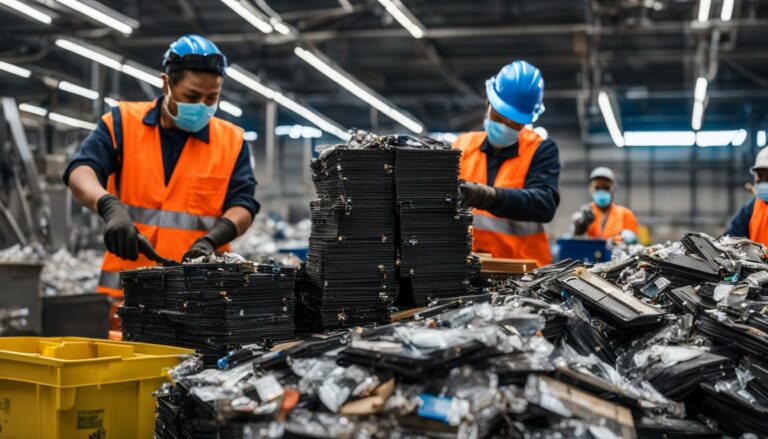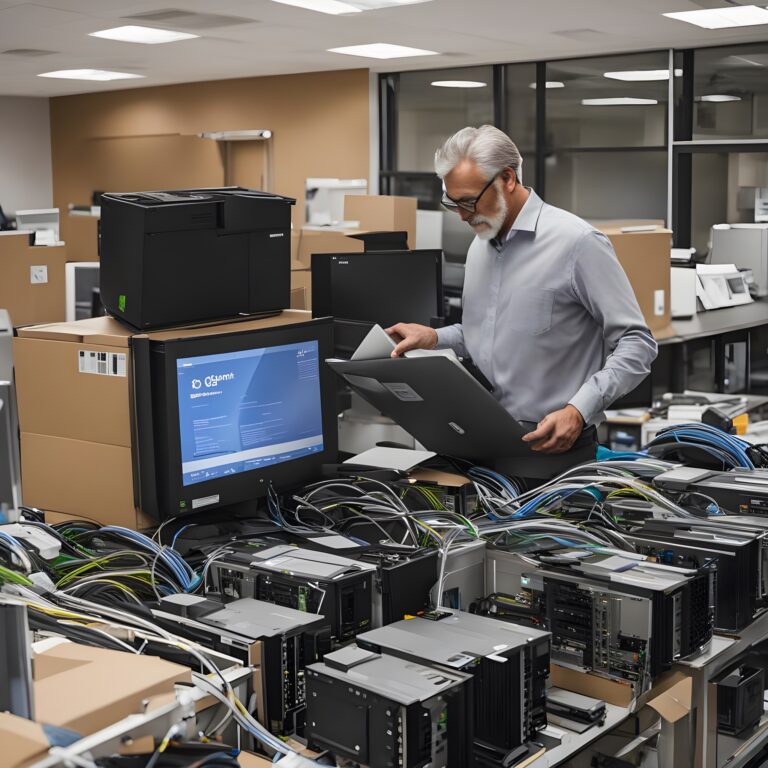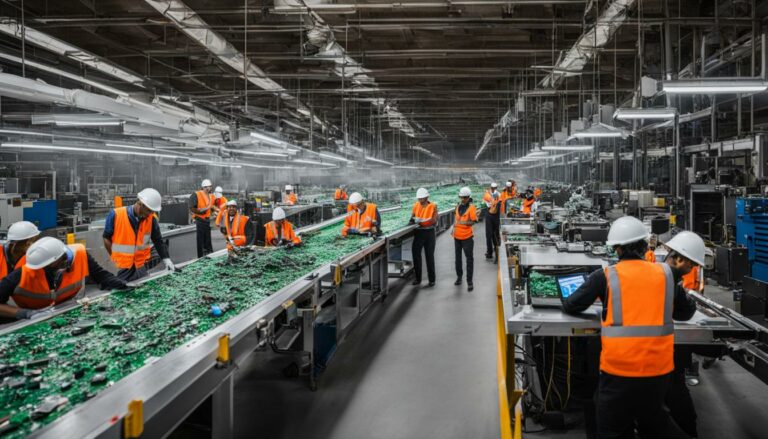IT Recycling for Non-Profit Organisations: A Guide
Non-Profit IT Recycling is an important practice that can have a positive impact on the environment. By responsibly disposing of old computers and other electronic devices, non-profit organisations can not only help protect the planet but also save money and maintain their green image. In the United Kingdom, the Waste Electric and Electronic Equipment (WEEE) Regulations require businesses to recycle their old computers to minimize environmental harm. This guide will provide information on how non-profit organisations can recycle their IT equipment and emphasize the importance of responsible disposal.
Key Takeaways
- Non-profit organisations can make a positive impact on the environment through IT recycling.
- Recycling old computers and laptops helps organisations save money and maintain their green image.
- The Waste Electric and Electronic Equipment (WEEE) Regulations in the UK require businesses to recycle their old computers.
- Proper IT disposal is essential to minimize harm to the environment.
- Non-profit organisations should choose reputable recycling options to ensure responsible IT disposal.
How to Recycle Old Computers and Laptops
Recycling old computers and laptops is essential to protect the environment and prevent hazardous materials from contaminating landfills. Non-profit organizations can play their part in responsible disposal by following these steps:
- Contact commercial waste collection services: Arrange for licensed waste carriers to collect your old computers and laptops. They will ensure that the equipment is taken to recycling facilities where materials can be recovered, reused, and recycled.
- Back up data and wipe the hard drive: Before recycling a computer, it’s important to back up any important data and wipe the hard drive to protect sensitive information. There are software programs available that can securely erase data, or you can seek professional assistance.
- Consider retailer take-back schemes: When purchasing a new computer, take advantage of retailer take-back schemes. Many retailers accept old computers for recycling, regardless of where they were originally purchased. This ensures that the old equipment is handled responsibly and recycled properly.
By following these steps, non-profit organizations can contribute to a more sustainable future and demonstrate their commitment to environmental responsibility.
Quote:
“Recycling old computers and laptops is not only environmentally friendly but also helps organizations save money and maintain their green image.” – Environmental Specialist
Retailer and Manufacturer Take-back Schemes
Non-profit organizations and individuals have convenient options for recycling their old computers through Retailer Take-back Schemes (RTS) and Distributor Take-back Schemes (DTS). These schemes ensure that computers are responsibly disposed of and recycled, contributing to a greener environment.
Retailer Take-back Scheme: When purchasing a new computer, the retailer is legally obligated to assist customers in disposing of their old computers in an environmentally friendly manner. Many high-street retailers offer collection services, irrespective of where the original purchase was made. This makes it convenient for non-profit organizations to recycle their old computers without hassle.
Distributor Take-back Scheme: Some retailers prefer to use Distributor Take-back Schemes, where local councils collect electrical waste on behalf of the retailers. These services are often free or subsidized by the retailer, covering the cost of recycling. It provides an added convenience for non-profit organizations to recycle their old computers, ensuring responsible disposal.
| Advantages of Retailer and Manufacturer Take-back Schemes | Benefits |
|---|---|
| Convenience | – Allows non-profit organizations to recycle old computers at the point of purchase |
| Cost-effective | – Some schemes offer free or subsidized collection services |
| Environmental Impact | – Ensures responsible disposal and recycling of old computers, reducing electronic waste |
“Retailer and Distributor Take-back Schemes provide a convenient and environmentally friendly solution for non-profit organizations and individuals to recycle their old computers. By partnering with retailers and utilizing these schemes, organizations can contribute to reducing electronic waste and promoting sustainable practices.” – Non-Profit IT Recycling Expert
The Computer Recycling Process
Recycling old computers is a crucial step in minimizing electronic waste and fostering a sustainable future. The computer recycling process involves several stages to ensure the safe and efficient disposal of old IT equipment. Here is a breakdown of the key steps involved:
1. Sorting and Testing
Once collected, the computers are sorted based on their type and condition. This allows for efficient processing and ensures that each computer receives the appropriate treatment. Computers that are deemed suitable for refurbishing and resale undergo rigorous testing to assess their functionality and performance.
2. Disassembling and Separating
After testing, the main components of the computer, such as circuit boards, hard disks, and sound cards, are disassembled. This enables the separation of different materials for recycling purposes. CRT monitors, which contain hazardous materials like lead, mercury, and cadmium, undergo specialized dismantling to remove these substances safely.
3. Data Destruction
Data security is a critical aspect of computer recycling. Before any recycling takes place, all sensitive information stored on the computers’ hard drives is securely wiped to prevent unauthorized access. This ensures that confidential data remains protected throughout the recycling process.
4. Shredding and Reusing
Once all useful and hazardous components are extracted, the remaining materials, such as plastics and metals, undergo shredding and further processing. These materials are then separated for reuse in the manufacturing of new products. This step helps conserve valuable resources and reduces the demand for raw materials.
| Step | Description |
|---|---|
| Sorting and Testing | Computers are sorted based on type and tested for refurbishing. |
| Disassembling and Separating | Main components are disassembled, and materials are separated for recycling. |
| Data Destruction | Sensitive data is securely wiped from the hard drives. |
| Shredding and Reusing | Remaining materials are shredded and separated for reuse. |
By following this comprehensive process, computer recycling ensures that old IT equipment is disposed of responsibly and contributes to a more sustainable future. It not only reduces electronic waste but also promotes resource conservation and protects against data breaches.
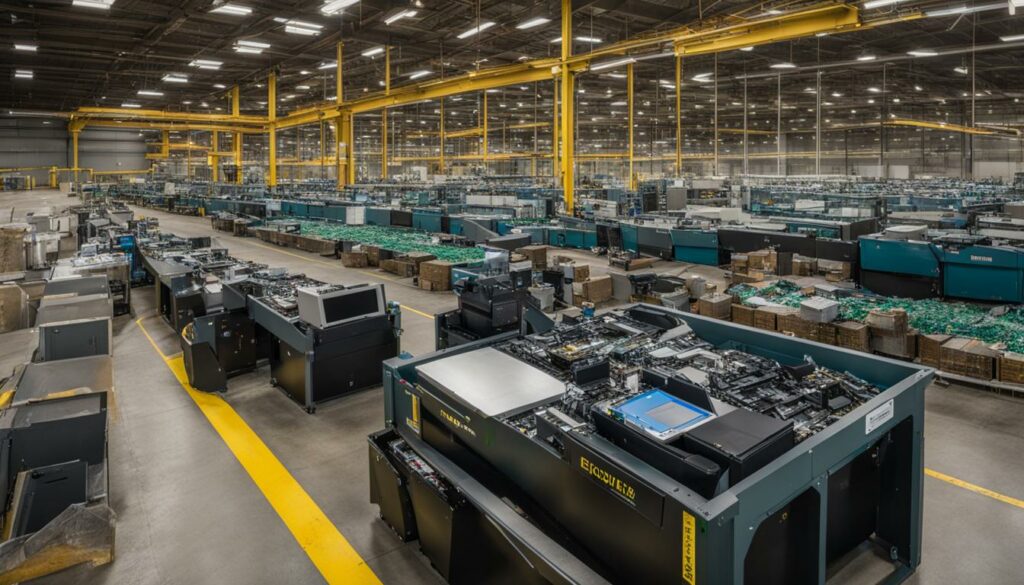
Benefits of Recycling Old Computers
Recycling old computers has significant benefits for non-profit organizations and the environment. By responsibly disposing of old IT equipment, organizations can minimize their environmental impact and contribute to reducing CO2 emissions. Here are some key benefits of IT recycling:
- Environmental Impact: Recycling old computers helps prevent them from ending up in landfills where hazardous materials can contaminate the soil and water. By keeping these devices out of the waste stream, non-profit organizations can protect the environment and preserve the local ecosystem.
- Reducing CO2 Emissions: The production of new computers requires a significant amount of energy and resources. By recycling and refurbishing old computers, non-profit organizations can reduce the demand for new devices, thereby decreasing the carbon emissions associated with manufacturing and transportation.
- Conserving Resources: The recycling process involves recovering and reusing valuable materials from old computers, such as metals and plastics. By extracting these resources from discarded devices, non-profit organizations can support a more circular economy and conserve natural resources.
- Supporting Green Initiatives: Recycling old computers helps non-profit organizations maintain their green image and demonstrate their commitment to environmental responsibility. It showcases their dedication to sustainable practices and can attract donors and supporters who align with these values.
By understanding the benefits of recycling old computers, non-profit organizations can make informed decisions regarding the proper disposal of their IT equipment. It is crucial to choose recycling options that ensure responsible and environmentally friendly practices, such as participating in take-back schemes, arranging commercial waste collection services, or donating to charity shops. By taking these steps, non-profit organizations can make a positive impact on the environment while maintaining their commitment to sustainability.
Where to Recycle Computers
Non-profit organizations have several options for recycling their old computers. By choosing the right method, organizations can ensure that their IT equipment is disposed of responsibly and recycled in an environmentally friendly manner. Here are some options for recycling computers:
Retailer Take-back
Many retailers participate in take-back schemes where customers can return their old computers when purchasing new ones. This ensures that the retailer takes responsibility for disposing of the old equipment properly. Retailer take-back schemes are convenient and often free or subsidized by the retailer. Non-profit organizations can take advantage of this option by returning their old computers to the retailer where they were purchased.
Commercial Waste Collection
Arranging commercial waste collection services is another effective way for non-profit organizations to recycle their old computers. These services ensure that the IT equipment is handled by licensed waste carriers and taken to recycling facilities. Commercial waste collection services are specifically designed for businesses and can be tailored to accommodate the specific needs of non-profit organizations.
Donation
If the old computers are still in working condition, non-profit organizations can consider donating them to charity shops or community projects. This enables the computers to be reused, extending their lifespan and reducing electronic waste. Donating old computers not only benefits the organization receiving the donation but also helps non-profit organizations demonstrate their commitment to social responsibility.
Online Resale
Online platforms such as Facebook Marketplace, eBay, and Gumtree provide opportunities for non-profit organizations to resell their old computers and parts. This option allows them to recover some of the investment made in purchasing the equipment while also giving others a chance to acquire affordable technology. When reselling old computers online, it is important to ensure that any personal data has been securely wiped from the devices.
By choosing one of these options, non-profit organizations can ensure that their old computers are recycled responsibly, contributing to a more sustainable future.
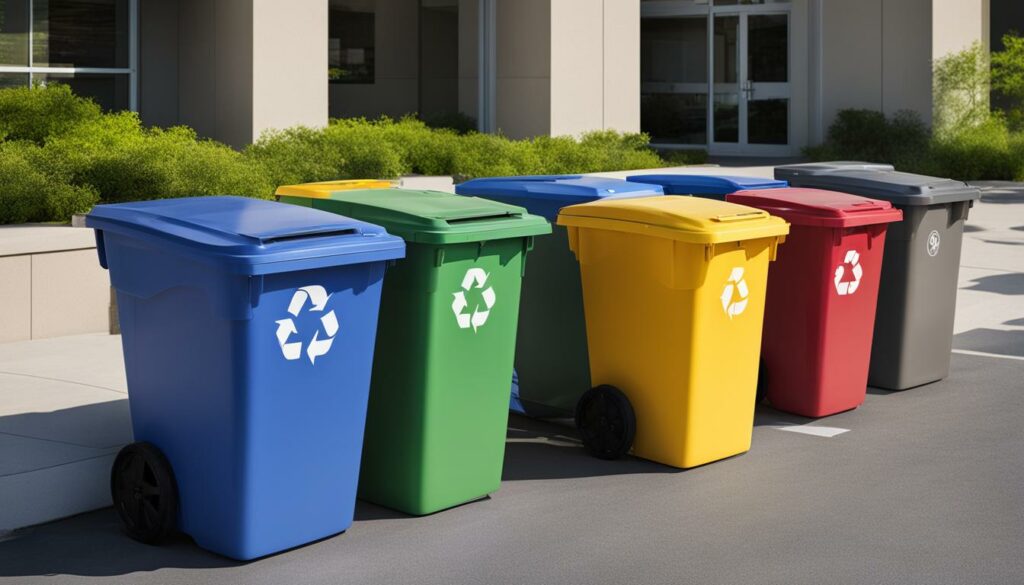
Conclusion
Non-profit IT recycling plays a critical role in promoting responsible IT disposal and reducing electronic waste. By implementing proper recycling practices, non-profit organizations can contribute to a more sustainable future. Recycling old computers and laptops not only protects the environment but also helps organizations save money and maintain their green image.
Non-profit organizations should take advantage of retailer take-back schemes, commercial waste collection services, and donation options to ensure that their old IT equipment is recycled responsibly. By choosing reputable recycling options, they can be confident that their equipment will be properly disposed of and recycled, minimizing environmental impact and supporting green initiatives.
In conclusion, responsible IT disposal is essential for non-profit organizations to uphold their commitment to environmental stewardship. By recycling old computers and laptops, these organizations can make a positive impact on the environment, reduce electronic waste, and contribute to a more sustainable future. It is crucial for non-profit organizations to prioritize IT recycling and choose responsible disposal methods to maximize their impact and demonstrate their dedication to environmental responsibility.
FAQ
What is the importance of recycling old computers for non-profit organizations?
Recycling old computers is important for non-profit organizations because it helps protect the environment, saves money, and maintains their green image.
How can non-profit organizations recycle their old computers?
Non-profit organizations can recycle their old computers by arranging commercial waste collection services, participating in retailer take-back schemes, or donating them to charity shops or community projects.
What should non-profit organizations do before recycling a computer?
Non-profit organizations should back up their data and wipe the hard drive before recycling a computer to protect sensitive information.
What happens to old computers during the recycling process?
During the recycling process, old computers are sorted, tested for refurbishing, disassembled, and separated for recycling. Hazardous materials are removed, data is securely wiped, and remaining materials are shredded and separated for further processing and reuse.
What are the benefits of recycling old computers for non-profit organizations?
Recycling old computers helps non-profit organizations minimize the release of hazardous materials into the environment, reduce pollution levels and CO2 emissions, conserve resources, and support green initiatives.
Where can non-profit organizations recycle their old computers?
Non-profit organizations can recycle their old computers by returning them to the retailer, arranging commercial waste collection services, donating them to charity shops or community projects, or using online platforms for resale.







